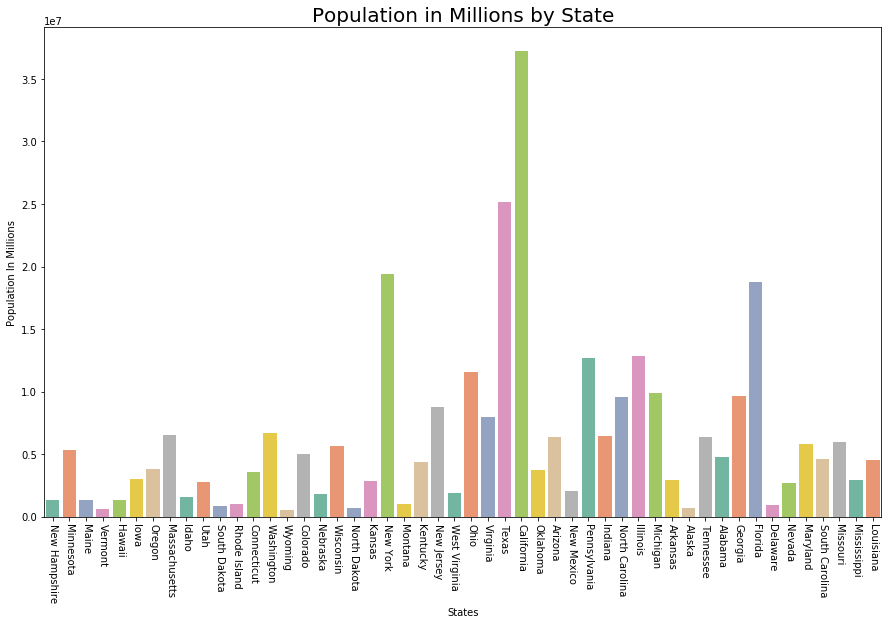Exploratory Data Analysis in Python | Set 2
Last Updated :
21 Jan, 2019
In the
previous article, we have discussed some basic techniques to analyze the data, now let's see the visual techniques.
Let's see the basic techniques -
Python3 1==
# Loading Libraries
import numpy as np
import pandas as pd
import seaborn as sns
import matplotlib.pyplot as plt
from scipy.stats import trim_mean
# Loading Data
data = pd.read_csv("state.csv")
# Check the type of data
print ("Type : ", type(data), "\n\n")
# Printing Top 10 Records
print ("Head -- \n", data.head(10))
# Printing last 10 Records
print ("\n\n Tail -- \n", data.tail(10))
# Adding a new column with derived data
data['PopulationInMillions'] = data['Population']/1000000
# Changed data
print (data.head(5))
# Rename column heading as it
# has '.' in it which will create
# problems when dealing functions
data.rename(columns ={'Murder.Rate': 'MurderRate'},
inplace = True)
# Lets check the column headings
list(data)
Type : class 'pandas.core.frame.DataFrame'
Head --
State Population Murder.Rate Abbreviation
0 Alabama 4779736 5.7 AL
1 Alaska 710231 5.6 AK
2 Arizona 6392017 4.7 AZ
3 Arkansas 2915918 5.6 AR
4 California 37253956 4.4 CA
5 Colorado 5029196 2.8 CO
6 Connecticut 3574097 2.4 CT
7 Delaware 897934 5.8 DE
8 Florida 18801310 5.8 FL
9 Georgia 9687653 5.7 GA
Tail --
State Population Murder.Rate Abbreviation
40 South Dakota 814180 2.3 SD
41 Tennessee 6346105 5.7 TN
42 Texas 25145561 4.4 TX
43 Utah 2763885 2.3 UT
44 Vermont 625741 1.6 VT
45 Virginia 8001024 4.1 VA
46 Washington 6724540 2.5 WA
47 West Virginia 1852994 4.0 WV
48 Wisconsin 5686986 2.9 WI
49 Wyoming 563626 2.7 WY
State Population Murder.Rate Abbreviation PopulationInMillions
0 Alabama 4779736 5.7 AL 4.779736
1 Alaska 710231 5.6 AK 0.710231
2 Arizona 6392017 4.7 AZ 6.392017
3 Arkansas 2915918 5.6 AR 2.915918
4 California 37253956 4.4 CA 37.253956
['State', 'Population', 'MurderRate', 'Abbreviation']
Visualizing Population per Million
Python3 1==
# Plot Population In Millions
fig, ax1 = plt.subplots()
fig.set_size_inches(15, 9)
ax1 = sns.barplot(x ="State", y ="Population",
data = data.sort_values('MurderRate'),
palette ="Set2")
ax1.set(xlabel ='States', ylabel ='Population In Millions')
ax1.set_title('Population in Millions by State', size = 20)
plt.xticks(rotation =-90)
(array([ 0, 1, 2, 3, 4, 5, 6, 7, 8, 9, 10, 11, 12, 13, 14, 15, 16,
17, 18, 19, 20, 21, 22, 23, 24, 25, 26, 27, 28, 29, 30, 31, 32, 33,
34, 35, 36, 37, 38, 39, 40, 41, 42, 43, 44, 45, 46, 47, 48, 49]),
a list of 50 Text xticklabel objects)
 Visualizing Murder Rate per Lakh
Python3 1==
Visualizing Murder Rate per Lakh
Python3 1==
# Plot Murder Rate per 1, 00, 000
fig, ax2 = plt.subplots()
fig.set_size_inches(15, 9)
ax2 = sns.barplot(
x ="State", y ="MurderRate",
data = data.sort_values('MurderRate', ascending = 1),
palette ="husl")
ax2.set(xlabel ='States', ylabel ='Murder Rate per 100000')
ax2.set_title('Murder Rate by State', size = 20)
plt.xticks(rotation =-90)
(array([ 0, 1, 2, 3, 4, 5, 6, 7, 8, 9, 10, 11, 12, 13, 14, 15, 16,
17, 18, 19, 20, 21, 22, 23, 24, 25, 26, 27, 28, 29, 30, 31, 32, 33,
34, 35, 36, 37, 38, 39, 40, 41, 42, 43, 44, 45, 46, 47, 48, 49]),
a list of 50 Text xticklabel objects)

Although Louisiana is ranked 17 by population (about 4.53M), it has the highest Murder rate of 10.3 per 1M people.
Code #1 : Standard Deviation
Python3 1==
Population_std = data.Population.std()
print ("Population std : ", Population_std)
MurderRate_std = data.MurderRate.std()
print ("\nMurderRate std : ", MurderRate_std)
Population std : 6848235.347401142
MurderRate std : 1.915736124302923
Code #2 : Variance
Python3 1==
Population_var = data.Population.var()
print ("Population var : ", Population_var)
MurderRate_var = data.MurderRate.var()
print ("\nMurderRate var : ", MurderRate_var)
Population var : 46898327373394.445
MurderRate var : 3.670044897959184
Code #3 : Inter Quartile Range
Python3 1==
# Inter Quartile Range of Population
population_IQR = data.Population.describe()['75 %'] -
data.Population.describe()['25 %']
print ("Population IQR : ", population_IRQ)
# Inter Quartile Range of Murder Rate
MurderRate_IQR = data.MurderRate.describe()['75 %'] -
data.MurderRate.describe()['25 %']
print ("\nMurderRate IQR : ", MurderRate_IQR)
Population IQR : 4847308.0
MurderRate IQR : 3.124999999999999
Code #4 : Median Absolute Deviation (MAD)
Python3 1==
Population_mad = data.Population.mad()
print ("Population mad : ", Population_mad)
MurderRate_mad = data.MurderRate.mad()
print ("\nMurderRate mad : ", MurderRate_mad)
Population mad : 4450933.356000001
MurderRate mad : 1.5526400000000005